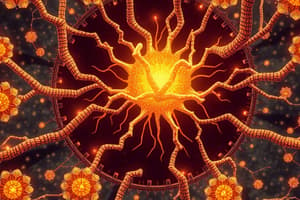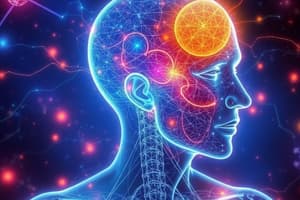Podcast
Questions and Answers
What is the fundamental purpose of any sensory receptor?
What is the fundamental purpose of any sensory receptor?
- To regulate body temperature
- To release neurotransmitters into the bloodstream
- To convert stimulus energy into nerve signals (correct)
- To convert nerve signals into stimulus energy
What is the term for the conversion of one form of energy to another in sensory receptors?
What is the term for the conversion of one form of energy to another in sensory receptors?
- Signal transmission
- Stimulus amplification
- Sensory adaptation
- Sensory transduction (correct)
What type of receptors mediate mechanosensation, thermosensation, sour (acid) and salt taste?
What type of receptors mediate mechanosensation, thermosensation, sour (acid) and salt taste?
- Metabotropic receptors
- Photoreceptors
- Chemosensory receptors
- Ionotropic receptors (correct)
What is the result of the deflection of the hair bundle in the direction of the tallest stereocilia?
What is the result of the deflection of the hair bundle in the direction of the tallest stereocilia?
What ion is involved in the depolarization of hair cells?
What ion is involved in the depolarization of hair cells?
What is the neurotransmitter thought to be released by hair cells?
What is the neurotransmitter thought to be released by hair cells?
What is the term for the channels involved in mechanosensation in hair cells?
What is the term for the channels involved in mechanosensation in hair cells?
How many molecular mechanisms of sensory receptor transduction are mentioned in the content?
How many molecular mechanisms of sensory receptor transduction are mentioned in the content?
What type of stimuli do mechanoreceptors react to?
What type of stimuli do mechanoreceptors react to?
What is the main function of proprioceptors?
What is the main function of proprioceptors?
What type of receptors are involved in mediating vision, olfaction, sweet, bitter, and umami tastes?
What type of receptors are involved in mediating vision, olfaction, sweet, bitter, and umami tastes?
What type of mechanoreceptors are found in the skin?
What type of mechanoreceptors are found in the skin?
Which mechanism produces the quickest response to the stimuli?
Which mechanism produces the quickest response to the stimuli?
What is the function of baroreceptors?
What is the function of baroreceptors?
What is the primary function of sensation?
What is the primary function of sensation?
Which of the following is an example of indirect gating?
Which of the following is an example of indirect gating?
What is the function of the Organ of Corti and vestibular system hair cells?
What is the function of the Organ of Corti and vestibular system hair cells?
What is the primary function of perception?
What is the primary function of perception?
What is the main function of tactile receptors?
What is the main function of tactile receptors?
How many types of tactile receptors are found in the skin?
How many types of tactile receptors are found in the skin?
What is the mechanism that is likely to produce a response lasting longer than the stimuli?
What is the mechanism that is likely to produce a response lasting longer than the stimuli?
What is the main difference between mechanoreceptors and other types of receptors?
What is the main difference between mechanoreceptors and other types of receptors?
What type of receptors are used in the sense of taste?
What type of receptors are used in the sense of taste?
Which sense uses both chemical and mechanical receptors?
Which sense uses both chemical and mechanical receptors?
What is the output of a generator or receptor potential in a sensory receptor?
What is the output of a generator or receptor potential in a sensory receptor?
What is the term for the minimum strength of stimulus required to excite a receptor?
What is the term for the minimum strength of stimulus required to excite a receptor?
What is the principle that states that a sensory receptor is specific to a particular type of stimulus?
What is the principle that states that a sensory receptor is specific to a particular type of stimulus?
Which of the following senses does not use chemical or mechanical receptors?
Which of the following senses does not use chemical or mechanical receptors?
What is the result of a change in the polarized state of a receptor when a stimulus is applied?
What is the result of a change in the polarized state of a receptor when a stimulus is applied?
What is the law that states that the sensation felt is specific to the receptor from which it carries an impulse?
What is the law that states that the sensation felt is specific to the receptor from which it carries an impulse?
The ______ barked
The ______ barked
Match the following programming languages with their primary usage:
Match the following programming languages with their primary usage:
Flashcards are hidden until you start studying
Study Notes
Mechanoreceptors
- Mechanoreceptors react to damaging stimuli, resulting in mechanical forces, including blood pressure, pain, extreme cold or heat, excessive pressure, stretching, and vibrations.
- They also respond to inflammatory chemicals.
Classification of Receptors - By Modality
- There are four classes of mechanoreceptors:
- Tactile receptors
- Proprioceptors
- Baroreceptors
- Organ of Corti and vestibular system hair cells
Tactile Receptors
- There are six types of tactile receptors in the skin that detect innocuous stimuli:
- Meissner's corpuscles
- Merkel's disks
- Free nerve endings
- Pacinian corpuscles
- Ruffini corpuscles
- C-fiber LTM (low-threshold mechanoreceptors)
Proprioceptors
- Proprioceptors are specialized mechanoreceptors that are usually present within muscle spindles, Golgi tendons, and joints.
- They report muscle length and movement information critical for motor control, limb position, and proprioception.
Baroreceptors
- Baroreceptors detect pressure.
- Types include:
- Carotid sinus and aortic baroreceptors
- Alveolar stretch receptors
- GI stretch receptors
- Urinary bladder stretch receptors
Organ of Corti and Vestibular System Hair Cells
- Hair cells of the inner ear are specialized mechanosensory cells that convert mechanical stimuli provided by sound waves or head movement into electrical signals.
Checkpoint
- Taste (gustation) uses chemoreceptors.
- Pain (nociception) uses both chemoreceptors and mechanoreceptors.
- Smell (olfaction) uses chemoreceptors.
- Touch uses mechanoreceptors.
- Vibration uses mechanoreceptors.
- Vision uses neither.
- Oxygen levels are detected by chemoreceptors.
- Pressure (baroreception) uses mechanoreceptors.
General Properties of Receptors
- Sensory receptors display properties common to almost all receptor types:
- Excitability
- Adequate stimulus is just enough strength of stimulus to excite receptors for the production of graded potential.
- Receptor protein specificity: Sensory receptors are optimally selective for a single type of stimulus.
Transduction Mechanism in Sensory Receptors
- The fundamental purpose of any sensory receptor is the conversion of stimulus energy into nerve signals.
- Sensory transduction is the conversion of one form of energy to another.
- Sensory signals begin as graded potentials that lead to the activation of an action potential or release of a neurotransmitter.
Hair Cells Transduction
- The deflection of the hair bundle in the direction of the tallest stereocilia increases the opening of mechanoelectrical transduction (MET) channels at the tips of the stereocilia, allowing an inflow of K+, resulting in a depolarizing receptor potential.
Salt and Sour Taste Transduction
- Direct activation of ion channels mediates mechanosensation, thermosensation, sour (acid) and salt taste.
Sensation and Perception
- Sensation is the process where sensory receptors receive information from both the internal and external environment and encode the information for transmission to various areas of the nervous system.
- Perception refers to the process where the CNS receives and interprets the sensations based on the present state of the internal and external environment, and the memory of similar situations.
Stimulus Location, Intensity, and Duration
- Stimulus location is coded by the neuron's receptive field.
- Stimulus intensity is coded by the number of receptors activated (population coding) and the frequency of action potentials (frequency coding).
- Duration refers to how long the stimulus lasts; if a stimulus is prolonged, firing of the neuron gets slower over time (sensory adaptation).
Studying That Suits You
Use AI to generate personalized quizzes and flashcards to suit your learning preferences.




